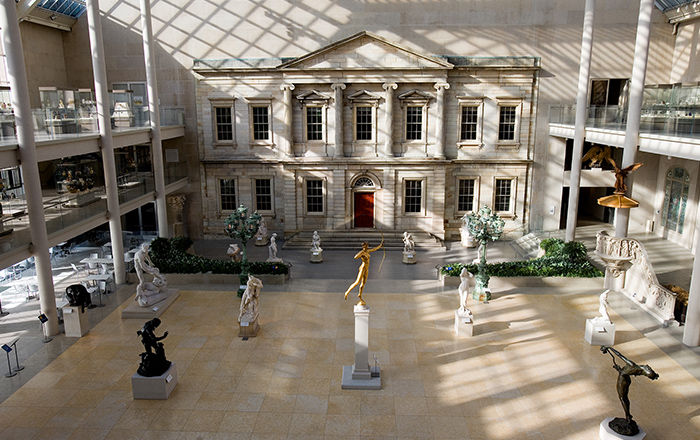Sampler
Anna Denlinger American
Not on view
Following her deep-rooted Mennonite heritage, Anna Denlinger cross-stitched this distinctive sampler using a group of stylized spot motifs found in samplers and on decorative towels embroidered by women who immigrated to Pennsylvania from Germany in the 17th and 18th centuries. Using a square format, Anna organized the classic designs in a mirrored layout with a geometric vine border bearing round berries on three sides.
At the top of her sampler, Anna inscribed a group of letters that are likely the first and last initials of the names of family members as they all end in “D” for “Denlinger”. Below the letters is an outlined square with her parents’ initials. It is flanked by large floral medallions of the well documented Mennonite motif that includes the letters OEHBDDE, the initials standing for the German motto “O Edel Herz Bedenk Dein End” (“Oh noble heart, think on thine end”). Below the floral medallions are a pair of stitched rectangles, each inscribed: “18 Anna 35/Denlinger.”
The bottom row of motifs features a central stylized vase of flowers in the middle of two pairs of facing birds standing on either side of a single stem of flowers. Below this is the inscription: “Anna Denlinger Was Born/The 18 July in The Year 1819.”
The Met Museum has another sampler made by Anna’s younger sister, Magdalena Denlinger (1820-1903) that follows a similar format (13.69.1b). The rural lifestyle of Pennsylvania Mennonite families meant that they were more likely to learn to sew at home rather than at an established school, and Anna and Magdalena may have copied a sampler made by their mother. While drawing from the same design, each girl added distinguishing characteristics. For example, Anna used the pair of traditional seven-armed heart motifs with the accompanying letters OEHBDDE, while Magdalena stitched a pair of more Anglicized motifs as a basket of flowers topped by a chirping bird and did not include the traditional letters. Both samplers have a bold pink and green border, stitched in a zig-zag pattern -- a feature characteristic of many important 19th century Pennsylvania samplers and an indication that they were intended for display in the family’s home.
Anna was eldest child of Jacob Resh Denlinger III (1788-1803) and Mary Kreider Landis Denlinger (1799-1875). Her great-great grandfather, the German-born Jacob Denlinger (1715-1787), was the progenitor of her father’s family and Denlingers became members of the Reformed Mennonite Church in Lancaster County. She and her six siblings grew up in Lancaster County and in 1845 she married David L. Weaver (1812-1887). Anna and David had four children, three boys, Jacob (b. 1846); David (b. 1849); and Benjamin (b. 1854); and one girl. Anna (b. 1858). The 1870 U.S. Census records them all living in East Hempfield, Lancaster Country, where David is listed as a farmer, and the value of their real estate at $9,950, and the value of their personal estate, $5,910. Anna lived until March 23, 1883 and she was buried in Landisville Reformed Mennonite Cemetery.
This image cannot be enlarged, viewed at full screen, or downloaded.

